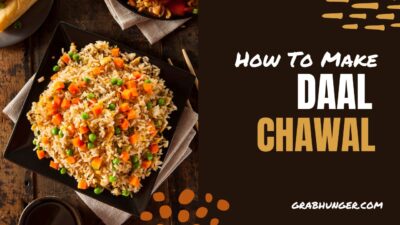
The Heart and Soul of Daal Chawal
Daal Chawal is far from being a dish to be served; it stands for home and hospitality itself. This dish, devoid of class and social limitations, cuts across rich lines and the poor’s wallet.
Hence enjoyed by many people of all walks in Pakistan, whether prepared with all pomp and grandeur and served in a sumptuous banquet or a very simple family dinner, one would never forget this lovely dish, Daal Chawal.
Nutrition Value
Daal Chawal has gained popularity mainly due to nutritional value. Lentils are full of proteins and fiber content and essential vitamins, which makes it one of the best, natural nutrition sources, above everything, for vegetarians as well as for those adopting a vegan diet. When along with rice that provides for carbohydrates, Daal Chawal becomes a proper meal with the advantage of being both filling and healthy.
Cultural Significance
In Pakistani culture, food interlaces the roots with a long line of family and cultural traditions. Often, this traditional food of Pakistan forms the cornerstone during many celebratory and religious festivities. For instance, during Ramadan, one might usually see the plating of Daal Chawal with loads of various chutneys and salads after the end time for fasting. Additionally, this dish is also an integral part of marriages and other social functions, where it is served along with meat dishes, creating a beautiful harmony of simplicity and indulgence in Pakistani culinary traditions. Moreover, its presence at these gatherings highlights the cultural significance and communal spirit associated with sharing food.
Preparing Daal
Ingredients
Daal Chawal Preparation starts with the daal. Daal can be prepared from different types of lentils. Some popular options include:
Moong Daal (Green Gram): Light and easily digestible, it cooks up very quickly and has a mild flavor.
Masoor Daal (Red Lentils): Earthy flavored and cooks into a soft paste.
Toor Daal (Pigeon Peas): Household staple; the taste and texture are pretty different.
Chana Daal (Bengal Gram): Nutty flavored, gives richness to the dish.
Preparation
Lentil Soaking
While some lentils don’t require soaking, it is soaked for 2 hours to reduce the time required for cooking and better digestibility.
Cooking Lentil
Put soaked lentils in a vessel with water, turmeric, and salt. It should be brought to a boil, then the flame reduced and cooked in a simmer until the lentil becomes soft. The cooking time may vary from 20 to 40 minutes with the type of lentil used.
Tempering(Tadka):
Once the lentils are cooked, prepare the tempering. Heat oil or ghee in a separate pan and add cumin seeds, chopped onions, green chilies, and garlic. Sauté until the onions are golden brown, then add tomatoes and spices like red chili powder, coriander powder, and garam masala. Let the oil separate from the masala.
Mixing:
Mix in the tempered mixture into the cooked lentils, and then add water to a desirable consistency. Let it simmer for a few minutes until all the flavors are melded together.
Preparation of Chawal
Ingredients
The rice accompanying the Daal Chawal is typically plain boiled basmati rice, famous for its long grains and aromatic properties.
Cooking Method
Rinsing the Rice:
Wash the basmati rice under running cold water till excess starch is gone. This step is vital to have fluffy rice.
Cooking Rice
Boil the water with salt in a pan. When the water boils, put the rice you had washed and continue to cook until it gets soft but still firm. This may take approximately 10-15 minutes.
Once cooked, drain the rice in a colander and let them sit for some time. This way all the excess moisture evaporates, and you have a perfectly cooked, fluffy rice.
Serving Daal Chawal
Daal Chawal can be enjoyed hot as a bowl food with heaps of daal drenched all over the chawal. To give it a flavor, it can be seasoned by adding a sprig of fresh coriander or a dollop of lemon juice and even a smear of ghee. Usual accompaniments are as follows:
Pickles: Any spicy and sour achar can do the trick to make it even more delicious.
Yogurt: A tiny side bowl of plain yogurt can stabilize the spices as well as add creaminess.
Fresh sliced cucumbers, tomatoes, and onions add a crunchy freshness to the salad.
Variations of Daal Chawal
Moreover, this classic daal chawal is relished in the traditional version.
But the regional variations and adaptations have been plentiful:Daal Fry
Here, daal is cooked and fried with spices for a deeper flavor.
Daal Tadka:
This is generally a more elaborate process of tempering with various spices and sometimes even added cream, making it relatively more indulgent.
Spiced Daal Chawal: Some recipes mix a lot of spices or vegetables to add depth as well as texture to it.
Lentil Soup:
Daal can sometimes be thinned out so that it is served in the form of a soup accompanied by rice for that warm, comforting meal.
So, Daal Chawal is a dish that signifies more than just a meal in Pakistan. It means the celebration of a culture, tradition, comfort, and so much simplicity along with its nutritional content that makes it a basic dish in most households. Irrespective of whether Daal Chawal serves casual weeknightly needs or a grand get-together in the household, it remains an imperative dish for the Pakistani race. This is a classic dish, giving a delicious glimpse into the warmth and hospitality that defines Pakistani cuisine.
Daal Chawal’s flavors are embraced in more than just a meal.
But as a delightful experience nourishing the body and soul.

Leave a Reply